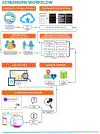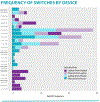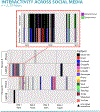Screenomics: A Framework to Capture and Analyze Personal Life Experiences and the Ways that Technology Shapes Them
- PMID: 33867652
- PMCID: PMC8045984
- DOI: 10.1080/07370024.2019.1578652
Screenomics: A Framework to Capture and Analyze Personal Life Experiences and the Ways that Technology Shapes Them
Abstract
Digital experiences capture an increasingly large part of life, making them a preferred, if not required, method to describe and theorize about human behavior. Digital media also shape behavior by enabling people to switch between different content easily, and create unique threads of experiences that pass quickly through numerous information categories. Current methods of recording digital experiences provide only partial reconstructions of digital lives that weave - often within seconds - among multiple applications, locations, functions and media. We describe an end-to-end system for capturing and analyzing the "screenome" of life in media, i.e., the record of individual experiences represented as a sequence of screens that people view and interact with over time. The system includes software that collects screenshots, extracts text and images, and allows searching of a screenshot database. We discuss how the system can be used to elaborate current theories about psychological processing of technology, and suggest new theoretical questions that are enabled by multiple time scale analyses. Capabilities of the system are highlighted with eight research examples that analyze screens from adults who have generated data within the system. We end with a discussion of future uses, limitations, theory and privacy.
Keywords: Mobile; cognitive science; communication; internet use; personal tools; software development; visualization.
Figures









Similar articles
-
Screenomics: A New Approach for Observing and Studying Individuals' Digital Lives.J Adolesc Res. 2020 Jan;35(1):16-50. doi: 10.1177/0743558419883362. Epub 2019 Nov 1. J Adolesc Res. 2020. PMID: 32161431 Free PMC article.
-
The Idiosyncrasies of Everyday Digital Lives: Using the Human Screenome Project to Study User Behavior on Smartphones.Comput Human Behav. 2021 Jan;114:106570. doi: 10.1016/j.chb.2020.106570. Epub 2020 Sep 15. Comput Human Behav. 2021. PMID: 33041494 Free PMC article.
-
ScreenLife Capture: An open-source and user-friendly framework for collecting screenomes from Android smartphones.Behav Res Methods. 2023 Dec;55(8):4068-4085. doi: 10.3758/s13428-022-02006-z. Epub 2022 Oct 26. Behav Res Methods. 2023. PMID: 36289177 Free PMC article.
-
Children's Privacy in the Big Data Era: Research Opportunities.Pediatrics. 2017 Nov;140(Suppl 2):S117-S121. doi: 10.1542/peds.2016-1758O. Pediatrics. 2017. PMID: 29093045 Review.
-
Young People's Online Help-Seeking and Mental Health Difficulties: Systematic Narrative Review.J Med Internet Res. 2019 Nov 19;21(11):e13873. doi: 10.2196/13873. J Med Internet Res. 2019. PMID: 31742562 Free PMC article.
Cited by
-
Charting adult development through (historically changing) daily stress processes.Am Psychol. 2020 May-Jun;75(4):511-524. doi: 10.1037/amp0000597. Am Psychol. 2020. PMID: 32378946 Free PMC article. Review.
-
Ethical issues in using ambient intelligence in health-care settings.Lancet Digit Health. 2021 Feb;3(2):e115-e123. doi: 10.1016/S2589-7500(20)30275-2. Epub 2020 Dec 21. Lancet Digit Health. 2021. PMID: 33358138 Free PMC article. Review.
-
Appnome analysis reveals small or no associations between social media app-specific usage and adolescent well-being.Sci Rep. 2024 Dec 28;14(1):30836. doi: 10.1038/s41598-024-81665-8. Sci Rep. 2024. PMID: 39730518 Free PMC article.
-
Screenomics: A New Approach for Observing and Studying Individuals' Digital Lives.J Adolesc Res. 2020 Jan;35(1):16-50. doi: 10.1177/0743558419883362. Epub 2019 Nov 1. J Adolesc Res. 2020. PMID: 32161431 Free PMC article.
-
Person-Specific Analyses of Smartphone Use and Mental Health: Intensive Longitudinal Study.JMIR Form Res. 2025 Feb 26;9:e59875. doi: 10.2196/59875. JMIR Form Res. 2025. PMID: 39808832 Free PMC article.
References
-
- Acquisti A, Brandimarte L, & Loewenstein G (2015). Privacy and human behavior in the age of information. Science, 347(6221), 509–514. - PubMed
-
- Agichtein E, Castillo C, Donato D, Gionis A, & Mishne G (2008, February). Finding high-quality content in social media. In Proceedings of the 2008 international conference on web search and data mining (183–194). ACM.
-
- Aharony N, Pan W, Ip C, Khayal I, & Pentland A (2011). Social fMRI: Investigating and shaping social mechanisms in the real world. Pervasive and Mobile Computing, 7(6), 643–659.
-
- Allcott H, & Gentzkow M (2017). Social media and fake news in the 2016 election. Journal of Economic Perspectives, 31(2), 211–36.
-
- Anderson C (2008). The end of theory: The data deluge makes the scientific method obsolete. Wired Magazine, 16(7), 16–07.
Grants and funding
LinkOut - more resources
Full Text Sources
